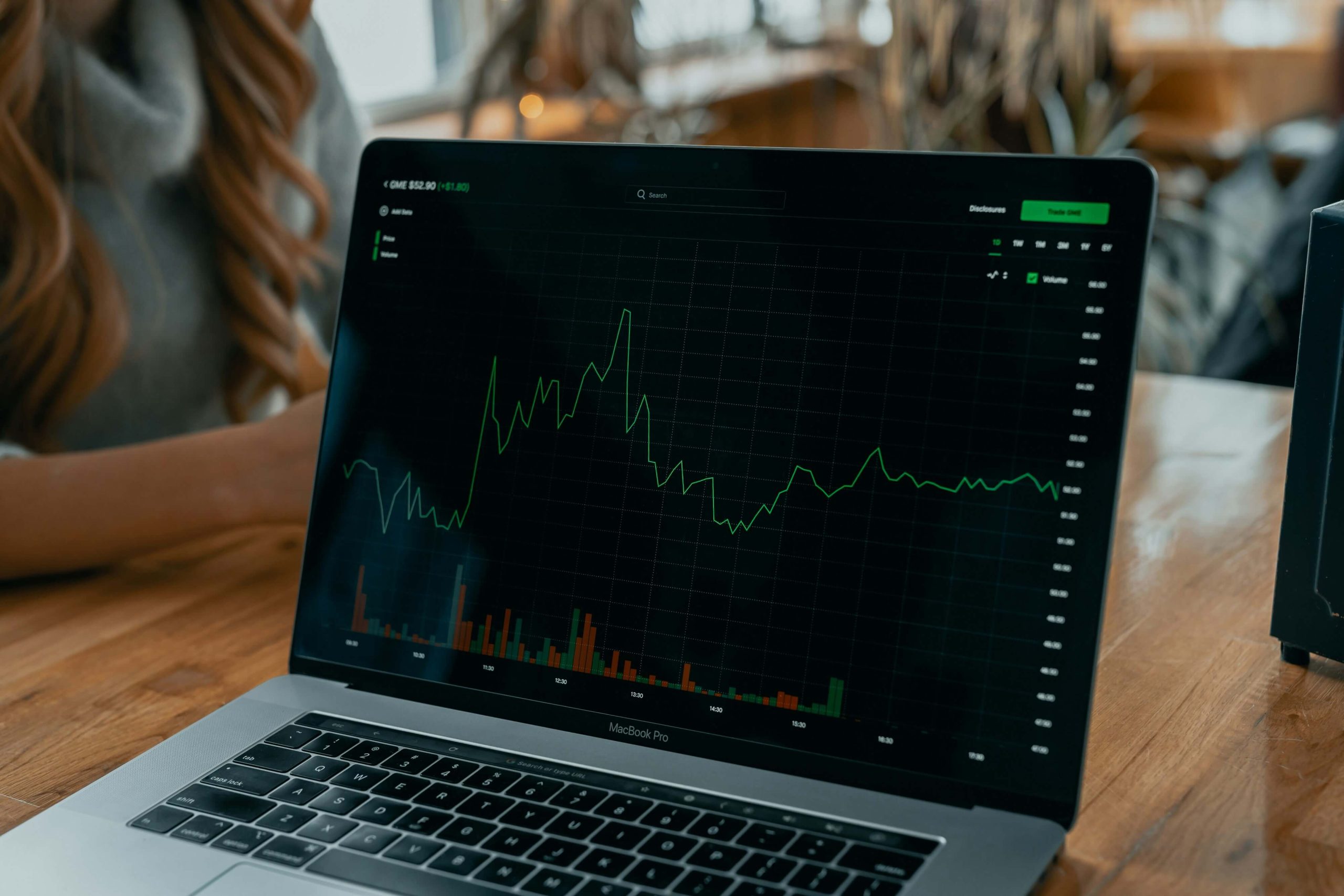How to Find Reliable Support and Resistance Levels Using Quotex
Learn to spot reliable support and resistance levels on Quotex. Utilize moving averages, Fibonacci retracement and extensions, Bollinger Bands, and pivot points to enhance your trading strategies.
A discussion about online trading on Quotex would be incomplete without mentioning support and resistance levels. These levels are the backbone of online trading. This article will take you through the fundamentals of support and resistance levels.
WHAT ARE SUPPORT AND RESISTANCE?
Support
In a downtrend, prices decline due to an abundance of supply compared to demand. As prices drop, they become more enticing to potential buyers waiting on the sidelines to purchase shares.
Eventually, the market, which may have been gradually increasing, reaches a point where it matches the existing supply. This moment marks when prices stop decreasing, a phenomenon known as “support.”
Support can manifest as a specific price level or a price range on a chart. In either case, it represents an area where buyers are eager to step in and make purchases. When demand overwhelms the supply at this level, the downward price movement stops and begins to reverse direction.
Resistance
Resistance is the antithesis of support. Greater demand than supply drives upward price movements. As prices climb, a moment will arise when selling pressure surpasses the eagerness to buy. This situation arises from various factors, such as traders deeming prices too high or meeting their profit targets.
Additionally, buyers might be hesitant to enter new positions at inflated valuations, among other reasons. Nonetheless, you can observe the point where supply starts to outweigh demand on a price chart. This point is known as “resistance,” and similar to support, it can manifest as a specific level or a broader zone.
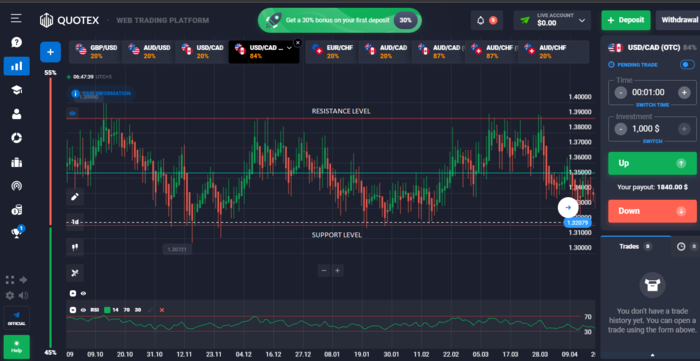
Why Is It Important to Find Reliable Levels?
Finding reliable support and resistance levels can be extremely useful when you’re doing online trading. Here’s how.
Investing and trading: You can utilize these levels to make accurate trade decisions. Recognizing intense support levels may encourage you to implement a long entry, expecting the price to bounce. On the other hand, identifying solid resistance levels can indicate a possible selling opportunity, anticipating a price reversal.
Risk management: The support and resistance levels can help you place appropriate stop-loss orders. Situating stops below the support or resistance can reduce the potential loss if the price reaches these critical points.
Price prediction: The historical patterns of support and resistance can give you clues about the future direction of prices. They function as a reference point, and if a price reaches or breaks through a significant support or resistance, this may indicate a substantial alteration in the underlying trend.
Market psychology: The support and resistance levels are not simply lines on a graph; they represent the psychological boundaries in the market. Traders typically respond to prices that are near these levels, which could lead to changes in the sentiment or behavior of the market.
Confirmation of trends: Support and resistance levels can help verify the legitimacy of a trend. You can interpret a succession of higher highs and higher lows as having an uptrend, while you can interpret lower highs and lower lows as having a downtrend. The support and resistance levels affect the identification of these patterns.
Entry and exit points: Constant support and reliable resistance levels provide a clear entrance and exit for commodities. You can strategically position yourself around these levels to enhance your transactions’ accuracy.
Volume and liquidity: The support and resistance levels often correspond to regions with higher volumes of trading and liquidity. You can enter trades at these levels with little to no deviation.
QUOTEX OVERVIEW
Before delving further into support and resistance levels, let’s talk about Quotex for a minute.
What Is Quotex?
Quotex is an internet-based brokerage company that enables you to trade across diverse asset classes, such as currency pairs, stock indices, cryptocurrencies, and commodities. They offer demo accounts, creating a safe and risk-free space to hone trading strategies. Once self-assured, you can open a live trading account with several deposit choices.
Depositing funds incurs no fees, and you can start with as little as 10 USD. Additionally, the company offers bonuses of up to 35% as an incentive. Moreover, Quotex provides user-friendly trading platforms, accompanied by active customer support, ensuring assistance is available whenever needed.
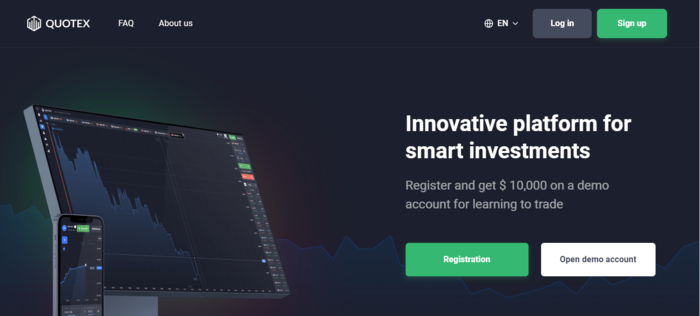
What Services Does Quotex Offer?
Quotex offers you numerous services, such as the following.
- Quotex offers a trading platform with sleek designs and a user-friendly interface. You can access this platform easily from your browser.
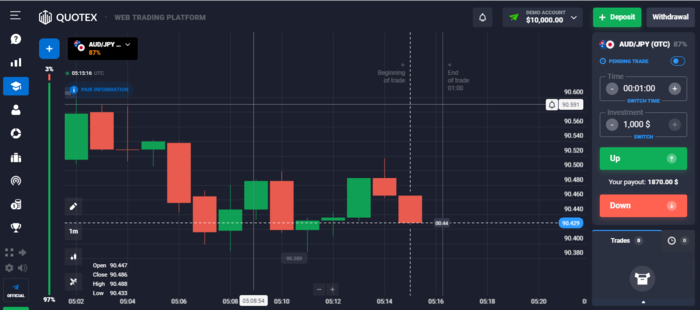
- You can trade on your mobile Android device on Quotex. The app for Android has most of the features of the web trading platform, with the added advantage of letting you trade anywhere, anytime. You can get this app from the Google Play Store.
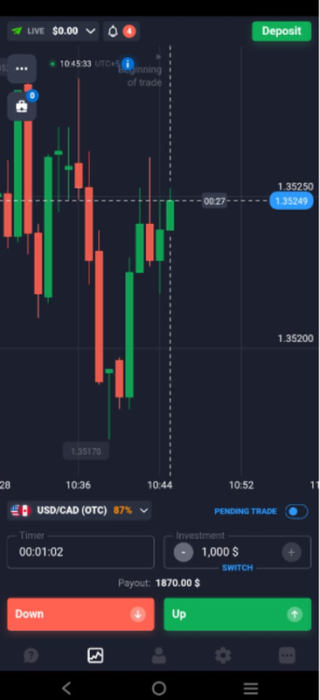
- Quotex offers you four asset classes. These include 26 currency pairs, stock indices, cryptocurrency, and commodities such as gold and silver.
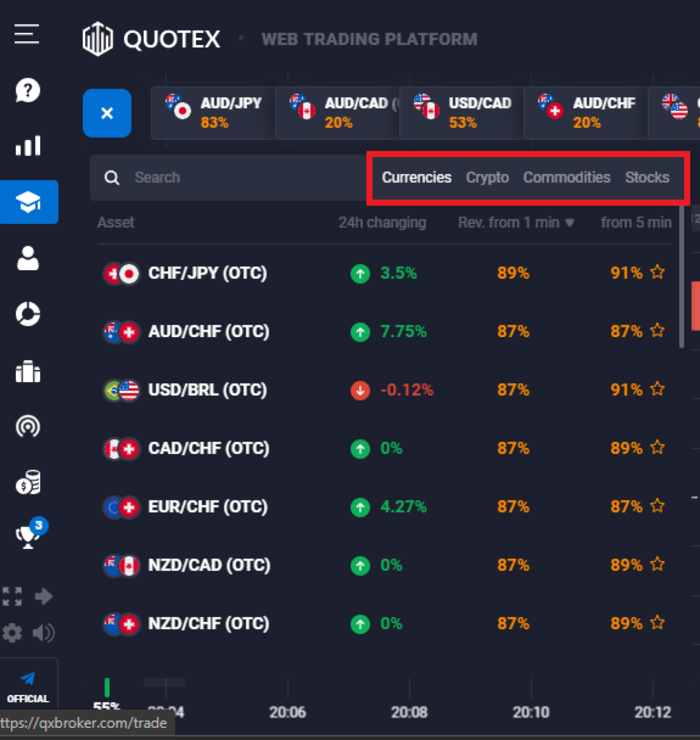
- You have access to the best trading indicators in the industry when you use Quotex. These include RSI, MACD, Bollinger Bands, and moving averages.
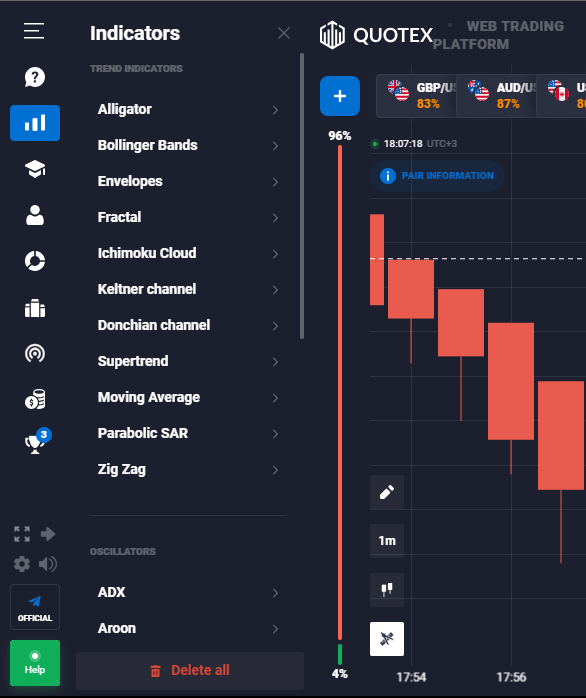
- Quotex offers you a demo account with actual market conditions. In this risk-free environment, you can work on your trading strategies, plan, and mentality. The company provides you with $10,000 for the demo account.
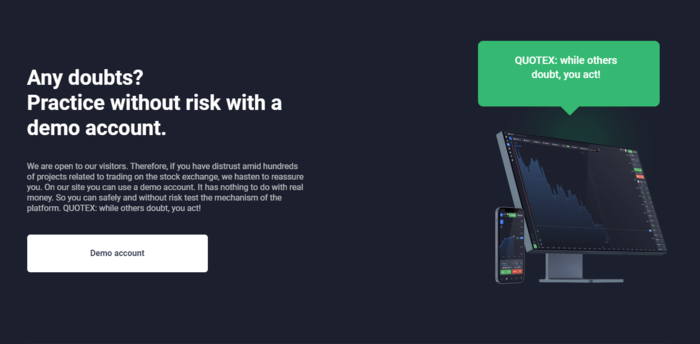
What Types of Traders Use Quotex?
Are you new to online trading? Or are you a seasoned trader and master of your craft? You don’t have to worry either way because Quotex has got you covered.
If you are new to trading, you can access the demo account, which allows you to trade risk-free. You can brush up on your trading skills before opening a real account.
As an experienced trader, you can access the vast array of technical indicators and tools that Quotex offers on its platforms. Thanks to the platform’s user-friendliness, you will have a comprehensive view of the charts.
TECHNICAL INDICATORS FOR FINDING SUPPORT AND RESISTANCE LEVELS
You can use price action to spot support and resistance levels. You can also use technical analysis to identify these levels. The latter involves the use of technical indicators. Below you’ll find more information about various technical indicators to identify support and resistance levels.
Moving Averages (MAs)
Moving Averages (MAs) is a concept that involves averaging price data over a specific period. The Simple Moving Average (SMA) and the Exponential Moving Average (EMA) are two widely used types. The SMA gives the same weightage to every data point, whereas the EMA assigns higher weightage to recent data.
When identifying support with moving averages, experiment with different periods to suit your trading style. In an uptrend, as the price approaches the moving average from below, it may find support and bounce back, acting as support levels. The commonly used 50-day SMA and 200-day SMA are options for this.
You can use moving averages to identify resistance levels in a downtrend. Selling pressure may occur as the price approaches the moving average from above, leading to a reversal in the downward movement. Typically, the 50-day SMA and 200-day SMA are useful in this situation.
Dynamic support and resistance: Moving averages change with each new data point. Therefore, they can continuously provide updated support and resistance levels as the market evolves.
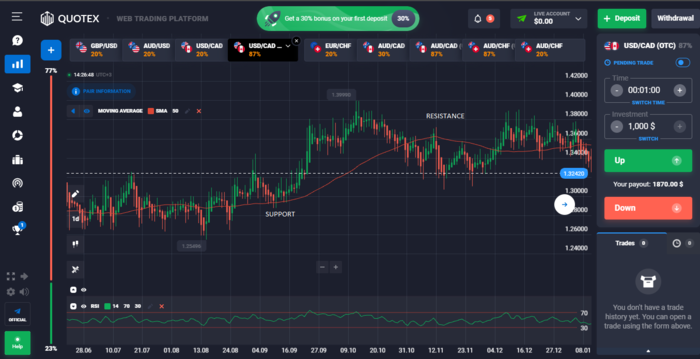
Fibonacci Retracement and Extensions
Fibonacci retracement and extensions are technical analysis instruments that help identify likely resistance and support in financial transactions. They emanate from the Fibonacci sequence, a series of numbers in which each is the sum of the previous two (e.g., 0, 1, 1, 2, 3, 5, 8, 13, 21, and so on). The most common levels of Fibonacci used in trading are 38.2%, 50.0%, and 61.8% for retracement and 161.8% and 261.8% for extensions.
Here’s how you can utilize Fibonacci’s retracement and extensions to recognize resistance and support:
Select a trend: First, choose a popular trend in the price increase or decrease, whether it’s an uptrend or a downtrend. This trend will be the pattern that you want to seek support or resistance.
Analyze the pattern: On the graph, locate the most recent high and low points associated with the trend. A swing high is the highest point achieved, and a swing low is the lowest.
Use Fibonacci levels: Once you have the up and down points, utilize the Fibonacci retracement levels in the chart. The levels will appear as horizontal lines at 38.2%, 50.0%, and 61.8% of the distance between the high and low swing.
Look for opportunities: The Fibonacci retracement levels serve as potential support (in an uptrend) or resistance (in a downtrend). Traders observe the price responses at these levels, such as the price returning to a Fibonacci number or passing through it.
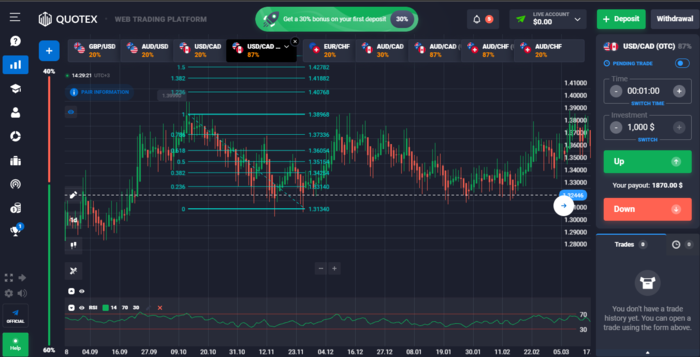
Bollinger Bands (BBs)
The middle band is representative of the average movement in the short term. This band is often set to a simple 20-day moving average (you can change the period based on your preferences).
The higher band is typically 2.5 standard deviations above the middle band. The lower band is typically 2.5 standard deviations below the middle band.
The higher Bollinger Band can function as a barrier, while the lower band can function as a support.
When the price is near the high end, it suggests that traders have oversupplied the market, and there may be potential resistance in the future.
Conversely, when the price is near the lower price range, it suggests that the market is oversold and that a potential support region is nearby.
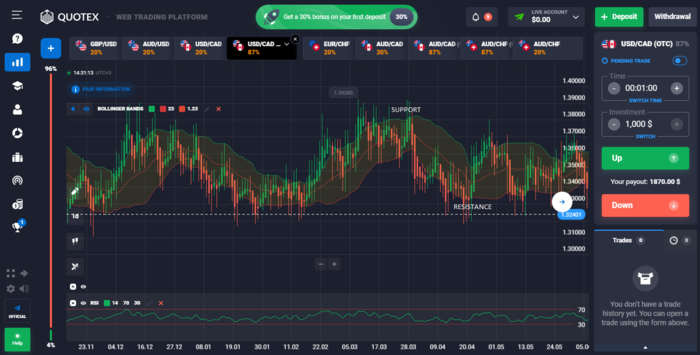
Pivot Points (PPs)
Pivot points are common in technical analysis. You calculate them based on the previous day’s high, low, and close prices. Here’s how to go about the calculations.
Calculate Pivot Point (PP)
To calculate the pivot point (PP), add the previous day’s high, low, and close prices, then divide the sum by 3.
PP = (Previous High + Previous Low + Previous Close) / 3
Calculate Support and Resistance Levels
Once you have the pivot point (PP), you can use it as a reference to calculate support and resistance levels.
You calculate the First Support (S1) and First Resistance (R1) by multiplying the PP by two and subtracting the previous day’s high and low prices, respectively.
S1 = (2 * PP) – Previous High
R1 = (2 * PP) – Previous Low
You calculate the Second Support (S2) and Second Resistance (R2) just as you did the first but use the PP, high and low prices from the previous day’s data.
S2 = PP – (Previous High – Previous Low)
R2 = PP + (Previous High – Previous Low)
Interpreting Pivot Points
You can use pivot points as crucial reference points. The price is considered bullish when it is above the pivot point, and the first resistance point becomes your target. If the price breaks above the first resistance point, then the second resistance point becomes your target.
On the other hand, the price is considered bearish when it is below the pivot point where your first support becomes the target. The following support becomes your target if the price breaks below this target.
Trend Lines
Trend lines are beneficial tools that help identify a price graph’s resistance and support. Here’s how you can effectively utilize them.
Draw a trend line: Look for peaks or troughs in price to recognize the trend. Connect higher lows with a straight line that represents an uptrend, and connect lower highs with a straight line to express a downtrend. These lines serve as your trend lines.
Recognize the support and resistance levels: During an uptrend, the trend line will function as support, and during a downtrend, it will function as resistance. Support levels are the price levels that typically attract buyer interest and promote recovery. Resistance levels are the price points at which the price encounters resistance and returns to its upward progression.
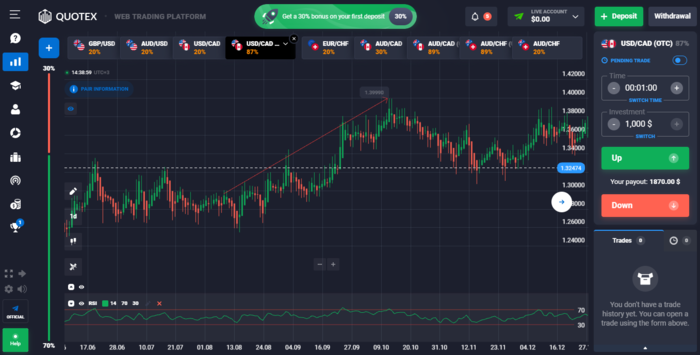
HOW TO USE THE INDICATORS TO FIND RELIABLE SUPPORT AND RESISTANCE LEVELS ON QUOTEX
Below is all you need to know about using indicators to find reliable support and resistance levels on Quotex.
Setting Up Your Charts
First, you must access the Quotex platform through your browser. On the trade execution window, click the indicator button at the bottom.
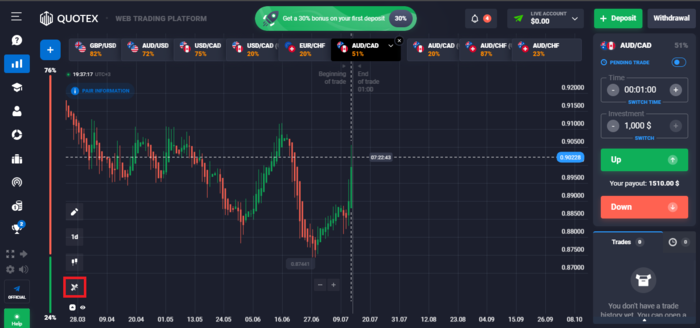
A list of available indicators will appear on your screen. You can then select the technical indicator you want. Set its parameters and begin trading.
Reading MA Signals
When the price retraces to the MA, the MA can act as support and provide a potential buying area in an uptrend. As the price rallies to the MA, the MA can act as resistance and offer a possible selling area in a downtrend.
BOTTOM LINE
Support and resistance levels are critical in online trading, significantly affecting prices. The better you understand technical indicators, the more you’ll be able to utilize these levels in trading.

